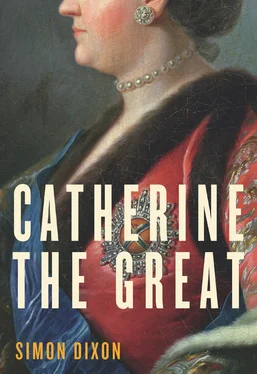53. Tooke, i: 219.
54. KfZh (1762), 39, 1st pagn; ‘Dnevnik statskogo sovetnika Mizere’, 59.
55. Bolotov, ii: 108–11.
56. Bil’basov, i: 423–4; 428–9.
57. PCFG , xxi: 164, Frederick to Prince Henry, 3 Jan. 1762; 175, to Finckelstein, 11 Jan. 1761 NS.
58. Ibid., 194, 22 Jan.; (210), 29 Jan.; (212), 31 Jan.
59. AKV , xxi: 46–7; SIRIO , xviii: 361, Mercy to Kaunitz, 28 May 1762 NS. Prince Dashkov reached Kiev before being recalled by Catherine.
60. Tooke, i: 239.
61. Ransel, Politics , 59–61 (61).
62. Troitskii, Finansovaia politika , 246–7; Leonard, Reform and Regicide , 122.
63. Kurukin, Epokha ‘dvorskikh bur’ , 385–92.
64. Leonard, Reform and Regicide , 136.
65. Madariaga, 27–8.
66. AKV , xxi: 49.
67. R. Vroon, ‘9 June 1762: The tears of an empress, or the toast that toppled an emperor’, in Days from the Reigns , ed. Cross, ii: 129–30.
68. Sochineniia , xii: 547, C. to Poniatowski, 2 Aug. 1762.
69. AKV , xxi: 68.
70. The following draws on Madariaga, 29–32, and Alexander, 3–16.
71. PSZ , xvi: 11,585.
72. R. Bartlett, ‘30 October 1763: The Beginning of Abolitionism in Russia’, in Days from the Reigns , ed. Cross, ii: 138.
73. Tooke, i: 292.
74. Osmnadtsatyi vek , 2 (1869), 634, Talyzin to Panin, 29 June 1762.
75. Perevorot 1762 goda (M, 1908), 141; Bil’basov, ii: 104–6.
76. Sochineniia , xii:.
77. A. Schumacher, Geschichte der Thronentsetzung und des Tode Peter des Dritten (Hamburg, 1858).
78. K. A. Pisarenko, ‘Neskol’ko dnei iz istorii “uedinennogo i priiatnogo mestechka”’, in O. A. Ivanov, V. S. Lopatin and K. A. Pisarenko, Zagadki russkoi istorii: XVIII vek (M, 2000), 253–398.
79. Madariaga, 32.
1. SIRIO , xii: 113, Buckinghamshire to Halifax, 28 June 1763 NS; cxl: 205, Bérenger to Praslin, 28 June and 8 July; xlvi: 538–40, Mercy to Kaunitz, 28 June.
2. Alexander, 74–5.
3. SIRIO , xxii: 66, 75, Solms to Frederick II; 7/18 June 1763; xii: 113, Buckinghamshire to Halifax, 28 June 1763 NS.
4. KfZh (1763), 109–11, 112–4, 117, 129; I. V. Kapustina, ‘Usad’ba Kuskovo v kontekste evropeiskikh paradnykh rezidentsii XVIII veka’, Russkaia usad’ba , 9 (2003), 163–81; Pis’ma Saltykovu , 14, 25 June 1763.
5. KfZh (1763), 131–42.
6. M. I. Pyliaev, Staryi Peterburg (SPb, 2007 edn.), 260. Begun in 1753, the church survived until 1961 when it was demolished during Khrushchev’s anti-religious campaign to make way for the Sennaia ploshchad’ metro station.
7. SIRIO , cxl: 206–7, Bérenger to Praslin, 12 July 1763 NS.
8. Zapiski Shtelina , i: 209; M. F. Korshunova, Iurii Fel’ten (Leningrad, 1988), 28. The gallery was demolished in 1766 as part of the scheme to clad the Neva’s banks in granite.
9. Rovinskii, Obozrenie ikonopisaniia , 279–80; Zapiski Shtelina , i: 256.
10. SIRIO , cxl: 206, Bérenger to Praslin, 12 July 1763 NS.
11. The longest of these memoranda is at SIRIO , x: 380–1, 20 Sept. 1769.
12. Madariaga, 123–32.
13. Bartlett, 30 October 1763, 139–40. See the same author’s ‘The Question of Serfdom: Catherine II, the Russian Debate and the View from the Baltic Periphery’, in Russia in the Age of the Enlightenment , eds. R. Bartlett and J. M. Hartley (London, 1990), 142–66, and his ‘Serfdom and state power in Imperial Russia’, European History Quarterly , 33 (2003), 38–9.
14. A. Kamenskii, Ot Petra I do Pavla I: Reformy v Rossii XVIII veka (M, 1999), 330.
15. R. Bartlett, ‘Educational Projects in the First Decade of the Reign of Catherine II’, in Russische Aufklärungsre  eption im Kontext offi
eption im Kontext offi  ieller Bildungskon
ieller Bildungskon  epte (1700–1825) , ed. G. Lehmann-Carli, et al. (Berlin, 2001), 109–24.
epte (1700–1825) , ed. G. Lehmann-Carli, et al. (Berlin, 2001), 109–24.
16. D. L. Ransel, Mothers of Misery: Child Abandonment in Russia (Princeton, NJ, 1988), 31–45.
17. Poroshin, 20, 29 Sept. 1764; 117, 9 Dec.; 133, 20 Dec; and passim .
18. W. Rosslyn, ‘5 May 1764: The Foundation of the Smol’nyi Institute’, in Days from the Reigns , ed. Cross, ii: 149.
19. See, in particular, her letters to ‘Dusky Levushka’ (Princess Cherkasskaia), from c . 1770: ‘Chetyre pis’ma Ekateriny II-y k kniagine A. P. Cherkasskoi’, RA , 1870, no. 3, 529–39.
20. PSZ , xvi: 11,606, 12 July 1762, referring to the Senate meeting on 3 July.
21. J. P. LeDonne, Ruling Russia: Politics and Administration in the Age of Absolutism 1762–1796 (Princeton, NJ, 1984), 27–30; L. G. Kisliagina, ‘Kantseliariia stats-sekretarei pri Ekaterine II’, in Gosudarstvennye uchrezhdeniia Rossii XVI—XVIII vv. (M, 1991), 171.
22. W. Daniel, Grigorii Teplov: A Statesman at the Court of Catherine the Great (Newtonville, MA, 1991); MP , iii: 144–53.
23. R. Faggionato, A Rosicrucian Utopia in Eighteenth-Century Russia: The Masonic circle of N.I. Novikov (Amsterdam, 2005), 16–21; Sochineniia , xii: 298, (406).
24. Kisliagina, ‘Kantseliariia’, 172–5; SIRIO , vii: 319, Teplov to Elagin, 12 Sept. 1763.
25. G. E. Munro, ‘Food in Catherinian St. Petersburg’, in Food in Russian History and Culture , eds. M. Glants and J. Toomre (Bloomington, IN, 1997), 31–48. Panin and Elagin reminisced about the imperial table in earlier eras: Poroshin, 23 Dec. 1764.
26. SIRIO , i: 261–2, C. to Mme Geoffrin, 4 Nov. 1763.
27. Parkinson, 48, 29 Nov. 1792.
28. Poroshin, 265, 28 Aug. 1765, records a visit of thirty minutes at Tsarskoe Selo: most apparently lasted about fifteen minutes.
29. O. A. Omel’chenko, Imperatorskoe Sobranie 1763 goda (Komissiia o vol’nosti dvorianskoi) (M, 2001), 13–48.
30. SIRIO , x: 381, 20 Sept. 1769; Madariaga, 43–7. Counting the backlog of Senate business became an annual obsession.
31. Quoted in Madariaga, 58.
32. RS , Nov. 1874, 494, C. to Volkov, June 1763.
33. Ekaterina II: Babushkina azbuka , ed. L.V. Tychinina (M, 2004), para. 45.
34. Ovsiannikov, Rastrelli , 173.
35. Ermitazh: Istoriia stroitelstva i arkhitektura zdanii , ed. B. B. Piotrovskii (Leningrad, 1989), 99–102; O. Medvedkova, ‘Catherine II et l’architecture à la francaise: le cas de Vallin de la Mothe’, in Catherine II et l’Europe , ed. Davidenkoff, 39–40; Zapiski Shtelina , i: 207.
36. SIRIO , xxii: 77, Solms to Frederick II, 3 June 1763.
37. KfZh (1763), 213.
38. Poroshin, 305–6, 8 Oct. 1765; McGrew, 56.
39. The following depends on G. N. Komelova, ‘Apartamenty Ekateriny II v Zimnem dvortse’, in Zimnii dvorets: Ocherki zhizni imperatorskoi rezidentsii, 1: XVIII-pervaia tret’ XIX veka (SPb, 2000), 44–73.
40. Benois, Tsarskoe Selo , 125; Poroshin, 307, 10 Oct. 1765.
41. AKV , xxxiv: 358, Panin to Anna Vorontsova, 11 Jan. 1767.
42. Poroshin, 54–5, 15 and 16 Oct. 1764; 192, 20 Feb. 1765. The machine was probably an electrostatic generator donated by Paul’s new science tutor, Franz Aepinus, a first-class scientist from Rostock whose treatise on electricity and magnetism had been published in St Petersburg in 1759. See R. W. Home, Electricity and Experimental Physics in Eighteenth-Century Europe (Hampshire, 1992), chs. XIV and XV.
Читать дальше

 eption im Kontext offi
eption im Kontext offi 










